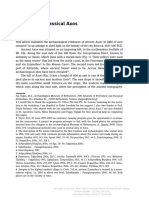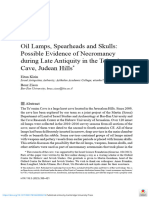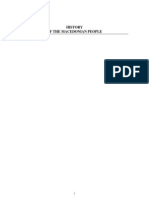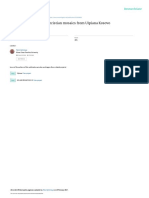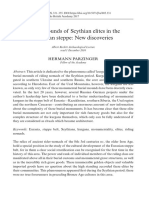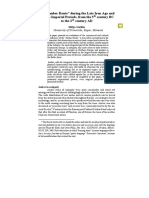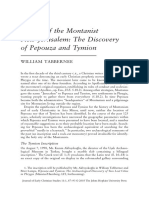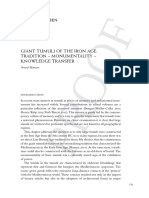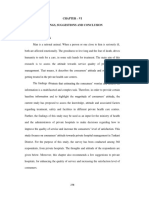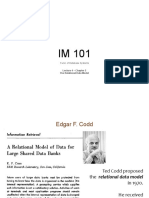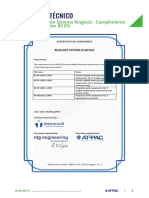PORTHMION
PORTHMION
Uploaded by
ZloypechenegCopyright:
Available Formats
PORTHMION
PORTHMION
Uploaded by
ZloypechenegCopyright
Available Formats
Share this document
Did you find this document useful?
Is this content inappropriate?
Copyright:
Available Formats
PORTHMION
PORTHMION
Uploaded by
ZloypechenegCopyright:
Available Formats
THE PORTHMION ARCHAEOLOGICAL EXPEDITION OF THE INSTITUTE OF THE HISTORY OF MATERIAL CULTURE (IIMK RAS)
Porthmion belongs to the so-called small Bosporan towns. Information on a settlement with this name is provided by ancient written sources (Ps.-Arr., Peripl. P. Eux. 50, 56, 91; Steph. Byz., s. v. Porqma ki Porqmon) where it is described as a kmh on the European side of the Cimmerian Bosporus, not far from Maiotis. It is quite obvious that the name is derived from the Greek porqmj (crossing). Indeed, both written and archaeological sources suggest that one of the traditional routes across the Kerch Strait ran close to the city, linking the Kuban region with the Crimea. Traditionally, Porthmion is identified with the Classical-period site situated north-east of what is now the city of Kerch. The regular excavation of the city began in 1953 by the Bosporan Archaeological Expedition of LOIA, AS USSR (now IIMK RAS). From 1953 until 1985 the excavations were carried out under the leadership of E. G. Kastanajan, in 19861990 and from 2002 they have been headed by M. Ju. Vakhtina. Administratively this expedition is still a branch of the Bosporan Archaeological Expedition of the IIMK, formerly a fairly large one but now composed of just a few independent groups. Porthmion is situated on a small plateau. The area of this plateau is 0.7 ha and it has actually determined the size of the Greek settlement during the whole period of its occupation. The excavations revealed that the city was fortified almost from its very foundation. The proximity to the traditional routes across the Cimmerian Bosporus gave certain economic advantages but at the same time presented a source of potential danger. Two periods the Archaic and Late Hellenistic have been fairly well studied during the years of excavations. To the first one belong the remains uncovered at the eastern excavated area. These include unique fortifications built by the first colonists. In 1986, the foundations of the Archaic eastern defensive wall of Porthmion were discovered. The wall was constructed from large limestone blocks along the NE-SW axis of the plateau. The maximum height of the preserved socle amounted to 1.2 m with a length of 2.8 m and a thickness of 1.01.1 m. Judging by the debris uncovered, the upper part of the wall was constructed from mud bricks. The
The Porthmion Archaeological Expedition
307
southern end of the wall was built up against a natural outcrop of rock, and here the structure formed a zigzag line resembling in outline a bastion. The southern line of the Archaic defences is rather poorly preserved, although it is clearly identifiable throughout the entire excavated area (approximately 25 m long). Those fortifications are related to the earliest period of the town and are dated probably to the second half of the 6th century BC. Inside the Archaic walls on the eastern slope of the rocky plateau, traces of a Late Archaic terraced building were uncovered.1 Excavations in recent years (20022005) have been concentrated mainly within that area. By the end of the 6th century BC, Porthmion must have suffered a catastrophe since traces of fire have been recorded over the entire area where any Archaic remains were discovered. The pottery from the level of destruction included a fragment of a black-figured lekythos of the late 6th century BC with a representation of an armed Scythian holding two horses (Fig. 1). From the area connected with the early fortifications and Late Archaic houses comes a fragment of the base of an Attic black-glazed bowl (Fig. 2) of the early 5th century BC with the graffito [---] X PARQENW[].2 In the second half of the 3rd century BC the settlement was completely rebuilt. During those activities, structures of the Classical period were almost completely destroyed. Therefore we do not know much about the town of the late 5th 4th century BC although numerous materials from the ruined buildings belong to that period (Fig. 3). Late Hellenistic Porthmion was a small fortress.3 New fortifications were erected simultaneously with the houses. The remains of the monumental northern and southern defensive walls and the northwest tower have been uncovered. The walls were built of large stone blocks on a stone base. The present height of the wall is over 2.5 m high with a width of up to 2 m. The rectangular northwest tower measured 9.97 9 m. It had an inner room of 26 sq. m. Here, a stone pavement containing a canine burial was discovered near the northern wall. The entrance to the city was revealed in its western wall. The Hellenistic town consisted of eight rectangular blocks
1 M. Ju. Vachtina, Archaic Buildings of Porthmion, in: P. G. Bilde (ed.), The Cauldron of Ariantas, Black Sea Studies 1 (Aarhus 2003) 3554. 2 . . , (S. R. Tokhtasyev, Dedicatory Graffito from Porthmion), in: . ( 1993) 7475. 3 E. G. Kastanajan, Porthmion, Centre darchologie Mditerranenne de lAcadmie Polonaise des Sciences. tudes et Travaux XIII (Warsaw 1983) 162168.
308
Marina Vakhtina
built along the E-W axis. The blocks were measuring on the average 63 11 m divided from each other by three longitudinal streets and one side street. The main longitudinal street, which divided the area of the city into two parts the northern and southern was 1.51.7 m wide. The Hellenistic houses had one or more rooms and yards. The living rooms had an area of 1520 sq. m, occasionally even 35 sq. m, that of the yards was up to 50 sq. m. The walls of the houses were built of limestone or shellrock, the roofs covered with Bosporan or Sinopean tiles. The Late Hellenistic town had an estimated population of c. 400. On the outskirts of Porthmion, the remains of small Hellenistic rural houses have been traced. In 1988, the remains of a similar rural house occupied in 3rd 2nd century BC were uncovered. During the recent years (20032005) the archaeological investigations of the settlement were concentrated on the remains of the Archaic fortifications and dwelling complexes. In 2003, excavations of the Porthmion necropolis situated on the plain west of the town began. An area with plain graves of the 4th century BC has been identified; in 2004, two Late Hellenistic grave crypts were unearthed. Porthmion was left by its inhabitants soon after mid. 1st century BC. The fort remained abandoned and has never been restored since.
Marina Ju. Vakhtina Institute of the History of Material Culture (IIMK RAS)
Porthmion
309
Fig. 2
Fig. 1
Fig. 3 Fig. 1. Fragment of an Attic black-figured lekythos Fig. 2. Fragment of the base of an Attic black-glazed bowl Fig. 3. Fragment of a clay figurine
You might also like
- A Mass Burial From The Cemetery of KerameikosDocument15 pagesA Mass Burial From The Cemetery of KerameikosLudwigRoss100% (1)
- Caskey 1968 Lerna BronzeDocument5 pagesCaskey 1968 Lerna Bronzesmitrovic482No ratings yet
- Sedimen TransportDocument55 pagesSedimen TransportOnni Linoarfrino100% (1)
- Decreased Cardiac OutputDocument4 pagesDecreased Cardiac OutputChristine MatasNo ratings yet
- Ancient - Sicyon - Revealing - Part - of - The - Hel - International Conference - SummeriesDocument40 pagesAncient - Sicyon - Revealing - Part - of - The - Hel - International Conference - SummeriesGeorgianna LaviniaNo ratings yet
- 75601-Arzhantseva & Zavyalov & Inevatkina-Por-Bajin-an-Uigher-Monument-from-Tuva-A015Document15 pages75601-Arzhantseva & Zavyalov & Inevatkina-Por-Bajin-an-Uigher-Monument-from-Tuva-A015Rodrigo Méndez LópezNo ratings yet
- Akurgal, Ekrem - The Early Period and The Golden Age of Ionia - AJA, 66, 4 - 1962 - 369-379Document20 pagesAkurgal, Ekrem - The Early Period and The Golden Age of Ionia - AJA, 66, 4 - 1962 - 369-379the gatheringNo ratings yet
- Boardman, J. - Greek Archaeology On The Shores of The Black SeaDocument19 pagesBoardman, J. - Greek Archaeology On The Shores of The Black SeapharetimaNo ratings yet
- Egyptian Pottery in Middle Bronze Age AshkelonDocument9 pagesEgyptian Pottery in Middle Bronze Age Ashkelonsychev_dmitryNo ratings yet
- Butrint Continues To Tell Its Story - Dhimosten BudinaDocument2 pagesButrint Continues To Tell Its Story - Dhimosten BudinalibrariNo ratings yet
- Archaeology in Georgia 1980-1990Document9 pagesArchaeology in Georgia 1980-1990Onur GüvenNo ratings yet
- Dakaris, 1967, A Mycenaean IIIB Dagger From The Palaeolithic Site of Kastritsa in EpirusDocument9 pagesDakaris, 1967, A Mycenaean IIIB Dagger From The Palaeolithic Site of Kastritsa in EpirusladuchessNo ratings yet
- Archaeopress Mortuary Variability and Social Diversity in Ancient GreeceDocument15 pagesArchaeopress Mortuary Variability and Social Diversity in Ancient GreeceEmra 1992No ratings yet
- Lazari Palli Rrecent Research in The Villa Rustica of Zavali, Ladochori, and The Roman Cemetery in MazarakiaDocument13 pagesLazari Palli Rrecent Research in The Villa Rustica of Zavali, Ladochori, and The Roman Cemetery in MazarakiaΚασσιανή ΛάζαρηNo ratings yet
- Archaeological Research in Detail: Klaina (Document1 pageArchaeological Research in Detail: Klaina (Ermanno RinaldiniNo ratings yet
- 2018 Lhuillier J and Bendezu Sarmiento CDocument23 pages2018 Lhuillier J and Bendezu Sarmiento Cs_cheshpeshNo ratings yet
- Santorini: Mesa VounoDocument6 pagesSantorini: Mesa VounoLander BiancaNo ratings yet
- Articule - Tell El-Farkha - Cialowicz Krzysztof MDocument14 pagesArticule - Tell El-Farkha - Cialowicz Krzysztof MGerardo P. TaberNo ratings yet
- THE GOLDEN GRAVE FROM ARZHAN Chugunov K, Nagler A, Parzinger H. 2001a. The Golden Grave From Arzhan. Minerva V13 (1) :39-42Document4 pagesTHE GOLDEN GRAVE FROM ARZHAN Chugunov K, Nagler A, Parzinger H. 2001a. The Golden Grave From Arzhan. Minerva V13 (1) :39-42Olenka AlexandraNo ratings yet
- Archaic and Classical Axos: Eva TegouDocument26 pagesArchaic and Classical Axos: Eva TegouSolange R. AmpueroNo ratings yet
- Oil Lamps Spearheads and Skulls Possible Evidence of Necromancy During Late Antiquity in The Teomim Cave Judean HillsDocument23 pagesOil Lamps Spearheads and Skulls Possible Evidence of Necromancy During Late Antiquity in The Teomim Cave Judean Hillsmartin guzmanNo ratings yet
- History of The Macedonian People - Institute of National History 2008 PDFDocument345 pagesHistory of The Macedonian People - Institute of National History 2008 PDFSedanur BiricikNo ratings yet
- A Sanctuary of The Thracian Hero in Sexaginta PristaDocument10 pagesA Sanctuary of The Thracian Hero in Sexaginta PristaGiuliaNo ratings yet
- A.karagianni-The Harbour of Proconnesus in Greco-Roman and Early Byzantine Times. (TEA 36, '12)Document7 pagesA.karagianni-The Harbour of Proconnesus in Greco-Roman and Early Byzantine Times. (TEA 36, '12)nedaoooNo ratings yet
- Archaic Greek Pottery in The Black Sea RegionDocument13 pagesArchaic Greek Pottery in The Black Sea RegionCodrin BucurNo ratings yet
- Tell Tweini - EnglishDocument5 pagesTell Tweini - EnglishHussein HayderNo ratings yet
- Cultural Heritage and Archaeological Investigation in East ThraceDocument26 pagesCultural Heritage and Archaeological Investigation in East ThraceVentzislav KaravaltchevNo ratings yet
- Butrint 6: Excavations on the Vrina Plain: Volume 2 - The FindsFrom EverandButrint 6: Excavations on the Vrina Plain: Volume 2 - The FindsNo ratings yet
- Two Decades of Archaeological Research IDocument36 pagesTwo Decades of Archaeological Research IJoe B. BryantNo ratings yet
- 1.3.1.2. 2015 - Madrid AIEMA Early Christian Mosaics From UlpianaDocument11 pages1.3.1.2. 2015 - Madrid AIEMA Early Christian Mosaics From UlpianathrasarichNo ratings yet
- The Greek Age of BronzeDocument23 pagesThe Greek Age of BronzeZorana DimkovićNo ratings yet
- History of The Macedonian People, Ed - Todor Chepreganov, Institute of National History, Skopje 2008.Document344 pagesHistory of The Macedonian People, Ed - Todor Chepreganov, Institute of National History, Skopje 2008.Документи за Македонската историја50% (2)
- A Contribution ToDocument8 pagesA Contribution ToPandexaNo ratings yet
- Prehistoric ArchitectureDocument5 pagesPrehistoric ArchitectureDino Amiel Bancaso Bongcayao100% (2)
- Prehistoric ArchitectureDocument5 pagesPrehistoric ArchitectureDino Amiel Bancaso Bongcayao0% (1)
- Prehistoric Architecture - Puro Bato 2021Document39 pagesPrehistoric Architecture - Puro Bato 2021Johann MacaballugNo ratings yet
- Cults of Isis and KoreDocument21 pagesCults of Isis and KoreValtair Afonso MirandaNo ratings yet
- Bronze Age EuropeDocument10 pagesBronze Age EuropeVíctor Alfonso Medina LugoNo ratings yet
- Sap - Western CrimeaDocument5 pagesSap - Western CrimeaΦούλη ΦανNo ratings yet
- Novi Test Inteligencije: MycenaeDocument5 pagesNovi Test Inteligencije: MycenaeWolf MoonNo ratings yet
- 15 Zollner Et Al CAA2007Document4 pages15 Zollner Et Al CAA2007abundzuNo ratings yet
- Chronological Sequence of The Early BronDocument34 pagesChronological Sequence of The Early BronИванова СветланаNo ratings yet
- Newly Discovered Early Christian Mosaics From Ulpiana KosovoDocument12 pagesNewly Discovered Early Christian Mosaics From Ulpiana KosovoДраган ЋирковићNo ratings yet
- Byblos An Ancient Capital of The LevantDocument24 pagesByblos An Ancient Capital of The LevantBassem KamelNo ratings yet
- Erdogu 2014 GOKCEADA - UGURLU Field Season 2011-2013Document22 pagesErdogu 2014 GOKCEADA - UGURLU Field Season 2011-2013DanaGrujićNo ratings yet
- Kachavara InvestigationsOnEsternBlackSeaDocument5 pagesKachavara InvestigationsOnEsternBlackSeaion ionNo ratings yet
- Burial Mounds of Scythian Elites, 2017Document26 pagesBurial Mounds of Scythian Elites, 2017Sinan SakicNo ratings yet
- The Amber Route During The Late Iron AgeDocument32 pagesThe Amber Route During The Late Iron AgeĐani NovakovićNo ratings yet
- Report On Underwater Investigation in AlexandriaDocument18 pagesReport On Underwater Investigation in AlexandriaStephan HullerNo ratings yet
- Excavations at Amorium 1992 Interim ReportDocument20 pagesExcavations at Amorium 1992 Interim Reporterkankaya06_23673525No ratings yet
- Archeolgogiko Ergo Thessalias Stereas Elladas 5 AbstractsDocument50 pagesArcheolgogiko Ergo Thessalias Stereas Elladas 5 AbstractsThanos SiderisNo ratings yet
- Structure in Arch 1st AssesDocument103 pagesStructure in Arch 1st AssesAbishaTeslin100% (1)
- VA - 2006 - Report of The 35th Saison at ElephantineDocument25 pagesVA - 2006 - Report of The 35th Saison at Elephantineoupouaout7No ratings yet
- Mesopotamia CivilizationDocument56 pagesMesopotamia CivilizationYashika TharwaniNo ratings yet
- Event 618 2Document4 pagesEvent 618 2Gech DebNo ratings yet
- Χanthopoulou et al. - 2014 - Local coarse waresDocument9 pagesΧanthopoulou et al. - 2014 - Local coarse waresMariaNo ratings yet
- MedIt Etruscan ArtDocument21 pagesMedIt Etruscan ArtMeredith GiltnerNo ratings yet
- Artigo em Inglês - Portals of The Montanist New Jerusalem The Discovery of Pepouza and TymionDocument7 pagesArtigo em Inglês - Portals of The Montanist New Jerusalem The Discovery of Pepouza and TymionFabiano SantiagoNo ratings yet
- Giant Tumuli of The Iron Age Tradition M PDFDocument15 pagesGiant Tumuli of The Iron Age Tradition M PDFMarko CekovićNo ratings yet
- A J of Arch 1906 p.104 On Mensa Ponder AriaDocument72 pagesA J of Arch 1906 p.104 On Mensa Ponder AriakellyfamilleNo ratings yet
- Town of Jajce - Temple of The God Mithra in JajceDocument6 pagesTown of Jajce - Temple of The God Mithra in Jajceapi-27049944No ratings yet
- 80 RecommendationDocument16 pages80 Recommendationarthik603No ratings yet
- Biomolecules: ChapterDocument42 pagesBiomolecules: ChapterBharatNo ratings yet
- Statement of Purpose (Ashok)Document2 pagesStatement of Purpose (Ashok)Sagar AryalNo ratings yet
- Final BUS 491CS Group PaperDocument43 pagesFinal BUS 491CS Group Paperjack stauberNo ratings yet
- Theory of Planning Behavior (TPB) andDocument19 pagesTheory of Planning Behavior (TPB) andnurfatehah265No ratings yet
- TJ 7003Document2 pagesTJ 7003Vidyadhar BommeriNo ratings yet
- DANGANTAKAR ZUCI..1 To..... - 1-1-1Document221 pagesDANGANTAKAR ZUCI..1 To..... - 1-1-1fatimamuhdsani34No ratings yet
- Delhi Public School Secunderabad NacharamDocument3 pagesDelhi Public School Secunderabad NacharamVedant SinghalNo ratings yet
- Notification For Backlog Recruitment UCEK JNTUK101017 1Document10 pagesNotification For Backlog Recruitment UCEK JNTUK101017 1Muqthiar Ali0% (2)
- Configuracion TLU76 PDFDocument17 pagesConfiguracion TLU76 PDFHenry RafaelNo ratings yet
- Your First 100 Tagalog Sentences 2nd Edition.1 PDFDocument39 pagesYour First 100 Tagalog Sentences 2nd Edition.1 PDFGabrielle Rivera100% (1)
- Life Cycle Cost Estimate For 2 ENERGY STAR Qualified Room Air Conditioner(s)Document11 pagesLife Cycle Cost Estimate For 2 ENERGY STAR Qualified Room Air Conditioner(s)selisenNo ratings yet
- Senior Project FinalDocument23 pagesSenior Project Finalapi-572879521No ratings yet
- Data Sheet of Clean Water Testing Environment Laboratory of PT - SucofindoDocument6 pagesData Sheet of Clean Water Testing Environment Laboratory of PT - SucofindobellaNo ratings yet
- Lecture 04 The Relational Data ModelDocument54 pagesLecture 04 The Relational Data ModelSharmainne PaleNo ratings yet
- 5 Solas of The Reformation PDFDocument2 pages5 Solas of The Reformation PDFLalpu Hangsing100% (3)
- Posttraumatic Psychological Symptoms Are Associated With Reduced Inhibitory ControlDocument11 pagesPosttraumatic Psychological Symptoms Are Associated With Reduced Inhibitory ControlChristian Vaca LopezNo ratings yet
- PDF File: Active Reading Skills Third Edition Short ReviewsDocument2 pagesPDF File: Active Reading Skills Third Edition Short Reviewsemran tabibianNo ratings yet
- Nursing Care Plan 2Document6 pagesNursing Care Plan 2ayanori_boyNo ratings yet
- (IJCST-V6I3P27) :rasha Mualla, Jafar AlkheirDocument9 pages(IJCST-V6I3P27) :rasha Mualla, Jafar AlkheirEighthSenseGroupNo ratings yet
- Introduction To Language TestingDocument29 pagesIntroduction To Language TestingTasya RamadaniNo ratings yet
- Report On Advance JavaDocument35 pagesReport On Advance JavaVertika Srivastava63% (8)
- Heliyon: Okpala Charles Chikwendu, Anozie Stephen Chima, Mgbemena Chika EdithDocument9 pagesHeliyon: Okpala Charles Chikwendu, Anozie Stephen Chima, Mgbemena Chika EdithDIEGO FERNANDO HUAMANI TORRESNo ratings yet
- Susan Spalding Press Release-AlzMN-NDDocument2 pagesSusan Spalding Press Release-AlzMN-NDLars LeafbladNo ratings yet
- Event Planner Coordinator Job DescriptionDocument2 pagesEvent Planner Coordinator Job DescriptionMy PhamNo ratings yet
- Certificados ATPACDocument5 pagesCertificados ATPACAndrés Marcelo Moya TejerinaNo ratings yet
- Lesson Plans PDFDocument11 pagesLesson Plans PDFapi-28305240150% (2)
- (Law and Practical Reason) Stefano Bertea - The Normative Claim of Law (2009, Hart Publishing)Document316 pages(Law and Practical Reason) Stefano Bertea - The Normative Claim of Law (2009, Hart Publishing)msilva_822508No ratings yet



















